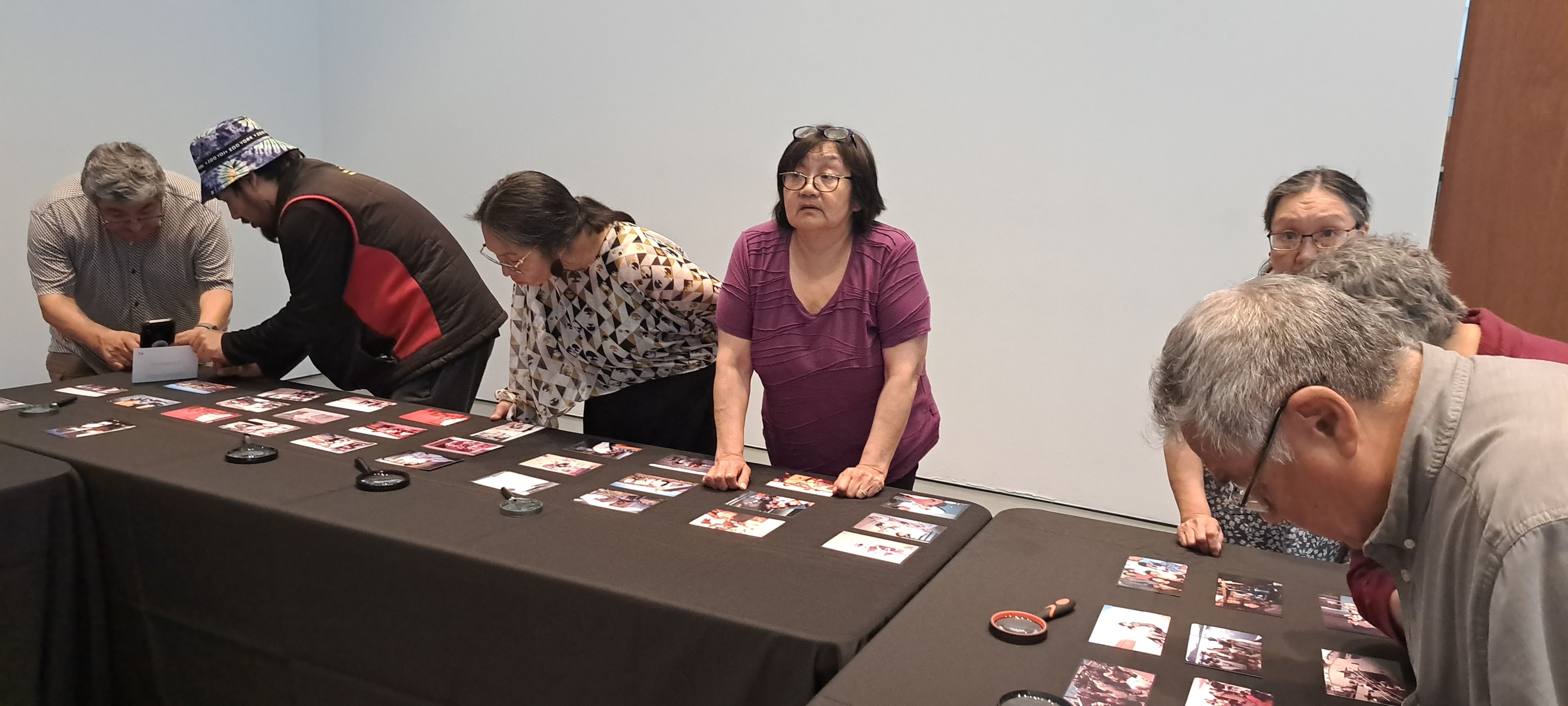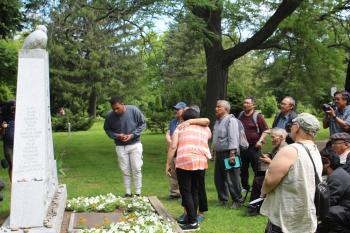Image Caption
Summary
Local Journalism Initiative Reporter
Windspeaker.com
Joanasie Akumalik understands well the emotions that ran through the Inuit survivors that made the trip to Hamilton last week to visit the site at which the Mountain Sanatorium was once located.
After all, his grandfather Pauloosie Akumalik was sent to that tuberculosis sanatorium in 1957. He died there and was buried in a nearby cemetery.
But the emotions weren’t as raw for him.
“Me and my father and my uncle already dealt with (my grandfather’s death) back in 2005,” said Akumalik. That was when they made the trip to the Hamilton cemetery and drank tea and ate bannock in Pauloosie’s memory.
During the 1940s to the 1960s tuberculosis peaked among Inuit communities with Canada shipping thousands of Inuit south to be treated in sanatoria. They were cut off from their language, their culture, their homes and their loved ones. Many died and were buried in unmarked graves without the knowledge of their families.
It was not only Akumalik’s grandfather who was shipped south.
Akumalik was separated from his mother when she was sent south to the Moose Factory Indian and Inuit Hospital, a TB sanitorium in Ontario. But she made it back home after two years.
“She told me stories that she was not allowed to go on the floor and (had to) stay in the bed, so the soles of her feet got some fat, and when she was able to get out of the bed, she had to learn to walk because her soles of her feet were fatty. It was painful for her,” Akumalik recalled.
He also recounts how she could speak Cree and made him First Nations toys like boats, canoes, bows and arrows, skills she learned from the First Nations patients who were also in Moose Factory.
Akumalik was only a child then and figures his mother must have been in her late 30s or early 40s when she took the ship south.
Akumalik also contracted TB, but he was treated with pills for about two years “and then I think I was cured.” He was allowed to remain in his Arctic Bay home on Baffin Island.
In 2019, Prime Minister Justin Trudeau apologized for the federal government’s treatment of Inuit during Canada’s management of the tuberculosis epidemic.
Trudeau also announce the launch of the Nanilavut Initiative. Nanilavut means “let’s find them” in Inuktitut.
However, the work on Nanilavut had begun almost a decade before with the federal government in partnership with Inuit Land Claims organizations, other Inuit organizations and the governments of Nunavut and the Northwest Territories. The work included establishing a database of information on those who were treated for tuberculosis, as well as those who passed away. The database is incomplete as there are partial or no records available.
Through the initiative Nanilavut Project managers were established. It was in this capacity that Akumalik accompanied the survivors to Hamilton. He helped coordinate the event as the Nanilavut Project Manager with Nunavut Tunngavik Incorporated (NTI).
The trip was in the making for about one-and-a-half years, says Akumalik.
He was invited to make a presentation by the Ilisaqsivik Society, a mental health organization in Clyde River. Ilisaqsivik was working with SeeChange Initiative, a non-profit that works globally to support communities lead their own health crisis responses.
Akumalik says there were Inuit at the presentation and discussion about visiting sanatoria took place. The discussion centred around it being a healing journey leading to closure.
Akumalik is clear that the emotional journey for the Elders who made the trip began well before they set foot on what was once the site of the Hamilton sanatorium where 1,200 Inuit were forced to stay.
“Asking them if they would be interested in going to Hamilton, that's where the emotion started. It brought back the memories of the trauma that they had to go through, going down to sanatorium without knowledge or…they could not speak English so it was very foreign,” he said.
As the group of nine Elders and four youth came from different communities throughout Nunavut, they made their way to Iqaluit and flew to Ottawa. Akumalik met them in Ottawa. From there they took a train to Toronto and connected to Hamilton.
“A lot of the Elders told me in this trip that once they started going on the train, it reminded them how things were going to the sanatorium, and the emotional part was at visiting the site the first day. It brought back memories and trauma that they went through,” said Akumalik.
The site has been demolished although the giant Cross of Lorraine still stands.
Hamilton Mayor Andrea Horwath has committed to installing new street signs for Sanatorium Road, as well as a plaque at Cross of Lorraine explaining the sanatorium’s history. Both will be translated into Inuktitut.
The group visited Woodland Cemetery in Hamilton. A monument has been erected to the 37 Inuit known to have died at Mountain Sanatorium. That stop was also “very emotional for them,” said Akumalik.
Three counsellors were part of the group that accompanied the Elders and youth along with three escorts and staff from NTI and SeeChange. The trip was paid for by NTI and SeeChange.
The group also viewed a collection of historic photos of sanatorium patients from the Health Sciences Archives at McMaster University and the Art Gallery of Hamilton’s Chedoke Collection of Inuit Art produced by Inuit sanatorium patients.

Akumalik says some Elders recognized faces in the photographs.
At the art gallery, “at one point there was a young lady whose father went to the sanatorium and she was…able to get her father's carving. So that was very emotional,” he said.
Akumalik says the trip was just as important for the youth as the Elders, even though for different reasons.
“We wanted to include the youth because it was an opportunity for them to learn the history of Inuit, what they went through and learn about TB as well as to learn about an advocacy role in bringing about TB elimination,” he said.
Tuberculosis continues to be a public health crisis in Inuit Nunangat. Inuit today are nearly 300 times more likely to contract TB than any Canadian-born, non-Indigenous person.
Five “debriefing sessions” are being held in August in various communities for those who made the Hamilton trip, as well as for their families and anyone interested in learning about the Nanilavut Project.
“The sessions’ goal is to provide health and wellness by gathering so that participants can share their experiences, learn about healing to reduce emotional and mental health impacts, and provide feedback to improve future events,” says the Facebook posting by the Inuvialuit Regional Corporation.
While no more sanatoria trips are planned at this point, said Akumalik, “we would like to do other regions as well.”
Local Journalism Initiative Reporters are supported by a financial contribution made by the Government of Canada.

